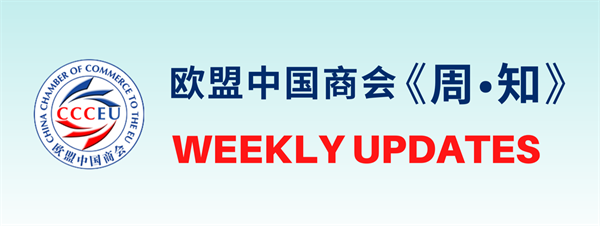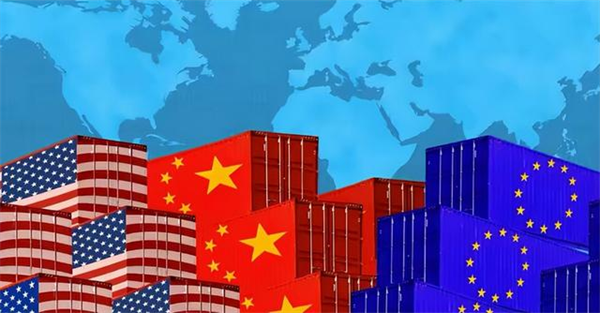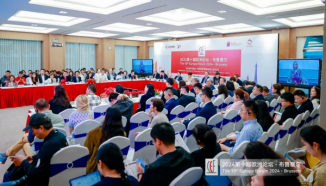The CCCEU Weekly Update June 9, 2023: EU Faces Scrutiny Over Trade Policies


Editor's Note: Greetings! The WTO conducted its 15th trade policy review of the EU this week. WTO members posed over 1,600 questions regarding the EU's recent trade policies, expressing concerns about measures such as the carbon border tax, foreign subsidies regulation, and anti-coercion instrument. Notably, China's exports to the EU declined by 4.9% between January and May compared to the same period last year. While smartphone, integrated circuit, and LCD module exports saw a significant decrease, automobile and component exports witnessed a surge. Wishing you an enjoyable read and a pleasant weekend.
▶︎ Focus
The World Trade Organization (WTO) recently conducted its 15th trade policy review of the EU in Geneva, Switzerland on June 5th and 7th. This marked the WTO's first assessment of the EU's trade policies in the post-pandemic era. The trade policy review is an integral part of the WTO's multilateral trading system, aiming to ensure transparency, provide feedback, address misunderstandings, and prevent trade disputes among member countries. All WTO members undergo regular reviews, with the frequency based on their global trade share. The EU's previous reviews took place in July 2017 and February 2020.
The WTO chairperson's closing remarks acknowledged the EU's commendable contributions to various areas, including swift pandemic response, WTO reform, dialogue and cooperation, environmental goals, combating overfishing, transparent rules, and trade assistance. Official meeting minutes will be released by the WTO in six weeks.
The EU's trade policy has substantial global impact due to its status as the largest trading partner among WTO members. Sabine Weyand, Director-General for Trade at the European Commission, emphasized the EU's commitment to a rules-based multilateral trading system in her speech. Ahead of the meeting, WTO members posed more than 1,600 inquiries about EU trade policies, with a particular focus on the following areas:
1. EU's green transition: Members expressed concerns about the potential negative trade impacts of the EU's carbon border adjustment mechanism, green taxation, government green procurement, and the deforestation-free regulation.
2. EU's digital transformation: Members highlighted both the opportunities and challenges brought about by the EU's digital strategy, as well as the Digital Services Act and Digital Markets Act.
3. EU's formulation of technical regulations: Members suggested that the EU should advance notification and consultation periods in the process of establishing technical regulations such as conformity assessments, the European standardization strategy, and standards related to environmental initiatives, which would ensure broader participation.
4. Strict tariffs and quotas on agricultural products entering the EU market: Concerns were raised regarding the stringent tariff and quota requirements for agricultural products seeking access to the EU market.
5. Continued use of trade remedies by the EU: Members expressed particular concerns about the EU's ongoing use of trade remedies such as anti-dumping, countervailing measures, and trade safeguards, including long-standing steel safeguard measures.
In addition, WTO members expressed worries about recent impending EU trade policies, such as the Foreign Subsidies Regulation, REACH, Waste Shipment Regulation, anti-coercion tools, Critical Raw Materials Initiative, Cyber Resilience Act, and the Net-Zero Industry Act. According to WTO requirements, the EU is expected to provide responses to all issues raised by other parties within one month.
China expressed concerns during the meeting about some of the recent trade-related policies adopted by the EU. Specifically, China pointed out that the EU's Foreign Subsidies Regulation creating new concept such as "transnational subsidies", foreign investment review system, and Critical Raw Materials Initiative were deemed unreasonable. China also criticized the discriminatory nature and market access restrictions posed by the EU's carbon border adjustment mechanism on products from developing countries. The Net-Zero Industry Act was seen as limiting the market share of third-party net-zero products. China also highlighted that the European Chips Act essentially expanded export controls and increased domestic subsidies, and considered these policies as deviating from international rules, including those of the WTO. Additionally, China expressed concerns about the EU's recently concluded political agreement on the anti-coercion instrument, which it believed opened the door for unilateral actions by the EU and potentially posed coercion to other WTO members and even companies.
The US also raised queries regarding the EU's proposed regulations. These included concerns about delayed notification of regulations, lack of transparency in the REACH regulation, the requirement for agricultural products to adhere to the EU production methods under the Farm to Fork strategy, excessively high approval requirements and low efficiency for genetically modified crops, restrictions on foreign suppliers' access due to the EU's new cloud service procurement network security certification program, exclusivity of the EU standards, and the absence of a unified EU customs administration. A total of 64 WTO member delegations, including China and the US, made statements during the review.
In response, João Aguiar Machado, the EU Ambassador to the WTO, stated that like many other members, the EU is concerned about the fragmentation of global trade, the weaponization of trade, and the global subsidy race. To address these new risks, the EU has decided to equip itself with tools such as anti-coercion instruments, enforcement regulations, or foreign subsidy regulations, while also not neglecting full compliance with WTO rules. The EU continues to implement strict and transparent state aid policies. The temporary rules introduced to address the current crisis must meet stringent criteria and will be time-limited. Regarding the green transition, the EU's Green Deal industrial plan is at the core of EU decisions and aligns with international commitments. The carbon border adjustment mechanism is not a trade policy but a climate-oriented environmental policy that will be applied in a fair and non-discriminatory manner to imported products. No financial adjustments will be made before 2026. However, the EU reiterated its commitment to carefully design and implement these policies to minimize potential negative spillover effects.
▶︎ Hot Topics
>>EU Approves €8.1 Billion Funding for Advanced Tech Project
The European Commission has granted approval for a groundbreaking project in microelectronics and communication technologies. Fourteen EU member states will jointly provide up to €8.1 billion in public funding. This Important Project of Common European Interest (IPCEI) involves 56 companies, including SMEs and startups, and encompasses 68 projects, making it the largest IPCEI to date in terms of participants, investment, and State aid.
The IPCEI's objective is to facilitate research and development of innovative and efficient technologies and components such as chips, processors, and sensors. These advancements can be integrated into various downstream applications and industries.
This recent approval follows the Commission's earlier endorsement of an IPCEI in the microelectronic sector in December 2018, which focused on enhancing chip energy efficiency, reliability, and accuracy.
>>EU Proposes €189.3 Billion Budget for 2024
The European Commission on Wednesday unveiled its proposed budget for 2024, amounting to €189.3 billion. Additionally, an estimated €113 billion will be allocated for grants under NextGenerationEU, a post-pandemic recovery initiative. The Commission emphasizes that these resources will sustain Europe's economic rebound, boost job creation, and enhance strategic autonomy. The budget prioritizes green and digital initiatives to fortify Europe's resilience and future readiness. The Recovery and Resilience Facility (RRF), a key component of NextGenerationEU, will provide grants and loans to support reforms and investments in the EU Member States. Contractual agreements under NextGenerationEU are expected to be finalized by the end of 2023, with associated payments continuing until 2026.
>>STMicroelectronics and Sanan plan silicon carbide venture in China
Accoording to Reuters, semiconductor supplier STMicroelectronics and Sanan Optoelectronics plan to set up a silicon carbide manufacturing joint venture in Chongqing, China, they said on Wednesday.
The companies said the cost of the venture was expected to be about $3.2 billion, including capital expenditure of about $2.4 billion over the next five years.
The venture will produce silicon carbide devices exclusively for STMicroelectronics which are used in electric cars and other industrial power and energy applications.
>>China's Nuode to Build USD553 Million Copper Foil Plant in Belgium
According to YICAI,Nuode New Materials, China's leading supplier of copper foil products, plans to invest EUR500 million (USD553 million) to build a plant in Belgium to better serve overseas clients that make power batteries.
>>Belgium Starts to Screen FDI as from July 1st
According to law firm DALDEWOLF, following the implementation of the Regulation (EU) 2019/452 of 19 March 2019 establishing a framework for screening foreign direct investments in the European Union (the FDI Regulation), it was much anticipated that all EU countries will eventually introduce foreign direct investment (FDI) screening mechanism at each national level.
It took some time for Belgium to start discussions on FDI screening mechanism within different federal and regional entities. On November 30, 2022, a draft Cooperative Agreement implementing a Screening mechanism for Foreign Direct Investment was published (the Cooperation Agreement).
The firm said the Cooperation Agreement was intended to take effect the beginning of 2023. It is now certain that the FDI screening mechanism will enter into force as of 1st of July.
>>China's exports to the EU fell year-on-year in the first five months
China's exports to the EU experienced a 4.9% decline in dollar terms during the first five months of this year, as reported by China's General Administration of Customs. The drop was particularly notable in categories such as cell phones, integrated circuits, and LCD modules. However, contrary to this trend, exports of automobiles and their components witnessed an increase.
▶︎ What are experts talking about?
What has changed in Europe's mindset after a flurry of visits to China by political dignitaries
From: Global Times
By: Dr.Henry Wang Huiyao, Dr. Mabel Lu MIAO
1. Baltic states want to "restart a new life"
A growing number of European elites now recognize the positive role China can play in persuading and promoting talks on Russian-Ukrainian relations. According to one European expert, the views of some EU member states on the Ukraine issue are increasingly converging with those of BRICS countries such as China, India, Brazil and South Africa.
2. Is it "re-linking" or "de-risking"?
On this topic, some European sources emphasize that the EU's "de-risking" is not specific to China, but a strategic decision made by the EU based on its own assessment of the economic and security environment. Some believe that it is the escalation of the Russia-Ukraine conflict that triggered the EU's "de-risking" thinking. Others explain that the EU's "de-risking" is largely directed at Russia, but for China, they believe that "de-risking" also means maintaining diversification, and that the EU needs to decide on its approach to China according to the needs of the market and the development of its own enterprises. The EU needs to decide its attitude toward China according to the market and the development needs of enterprises.
3. "The U.S. Indo-Pacific concept is Indo-Pacific is neither Indian nor Pacific"
Some European sources have repeatedly mentioned that the EU's diplomacy with the US and China is not "equidistant", and said that the EU will definitely prefer the US. However, some European sources said that as allies, the U.S. and Europe have common values, but there are huge economic interests with China, and the EU itself does not want to choose sides between China and the United States.
While following the U.S., the EU does not have a clear perception of some U.S. strategic concepts towards China, or rather, the interests are not yet clear. Many Europeans have a different understanding of the "The U.S. Indo-Pacific concept is Indo-Pacific is neither Indian nor Pacific". The Indo-Pacific concept is neither Indian nor Pacific, where the Indian Ocean region does not include Africa and the Middle East, and the Pacific region does not include China and Latin America.
4. Hope to experience the "China story" in China
Many Europeans expressed a strong desire to visit China more often and experience the "China story" on the ground. Some hope that it will be easier to visit China in the post-epidemic era and that there will be fewer "traffic jams". According to these Europeans, significantly lowering the threshold for "inbound tourism" is the most cost effective option for China to counter "decoupling".
Keeping America close, Russia down, and China far away: How Europeans navigate a competitive world
From: The European Council on Foreign Relations (欧洲对外关系协会)
By: Jana Puglierin, Pawel Zerka
This article is an excerpt from the Huanqiu New Media article "Embarrassing for the US? 11 European polls released, more than 40% of respondents consider China a 'necessary partner'".
On June 7, the European Council on Foreign Relations (ECFR) released the results of a poll of respondents from 11 European countries. The poll asked respondents in 11 countries about their views on Russia, the United States and China, and the results, it would be quite embarrassing for the United States.
(1) When asked about their views on China as a competitor to the United States, not only did half of the respondents in Sweden view China as an adversary, but in the other 10 countries, not only did such views not reach half, but the average of public opinion in these 11 countries showed that nearly half of the people also view China as a "necessary partner" or even an ally.
What is more interesting is that the percentage of respondents who see China as an " necessary partner" is the same as that of the United States, which is more than 40 percent. In Bulgaria, Hungary and Spain, more than 50 percent of respondents consider China as a partner or even an ally. The Netherlands and Austria also reached almost 50%.
(2) While nearly 80% of the European public believes that the United States is important to Europe, 60% of European respondents do not intend to choose sides in the event of a conflict between the United States and China over Taiwan, but prefer to remain neutral - even those willing to support the United States are only a little over 20%. Thus, the European External Relations Association has to admit that it seems that the European public is more on the side of French President Emmanuel Macron, does not see China as a force to be reckoned with, and does not buy into the "democracy vs. dictatorship" rhetoric preached by the United States. Moreover, even if China and Russia have good relations, this does not affect the attitude of most Europeans who consider China as a "necessary partner" for Europe.
END
Please note: the English version of this issue is slightly different from our Chinese one. The views and opinions expressed in this article do not necessarily reflect the official position of the CCCEU.

 Login
Login Login
Login CCCEU and Gunnercooke Successfully Host Webinar on CSDDD and FLR Compliance to Guide Chinese Businesses
CCCEU and Gunnercooke Successfully Host Webinar on CSDDD and FLR Compliance to Guide Chinese Businesses Cultivating responsible China-EU business leaders essential to tackling global challenges
Cultivating responsible China-EU business leaders essential to tackling global challenges



